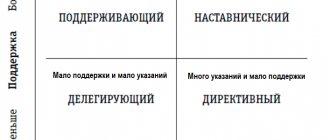The concept of “communication style” includes norms, methods, principles, patterns of human behavior and other features. The manner of conversation is a mirror reflection of our inner world, which is why each person, putting thoughts into verbal form, chooses special means and forms of self-expression. It is very difficult to always communicate correctly and politely with people. Every day we have to express our point of view or share our impressions under different circumstances: at home, among friends and acquaintances, at work, in transport, on the street, etc.
The specific communication style we choose depends on the specific situation.
I have a very narrow circle of friends, sometimes it narrows down to fish. Zemfira Ramazanova
In the process of communication, it is important not only to express your opinion, but also to be able to convey your thoughts to your interlocutor(s), so it is very important to choose an effective manner of presenting information.
Authoritarian communication style
It assumes the presence of rigid control levers that are in the hands of one person.
In such cases, all decisions are made individually and are not subject to discussion. A person who chooses this style of communication for himself, as a rule, uses various methods of suppressing others.
An authoritarian leader is always afraid of being overthrown, so he will try in every possible way to discredit his potential rivals.
The authoritarian communication style is characterized by the following features:
- All orders are given in a commanding tone.
- Lack of discussions, disputes, discussions.
- Suppression of any initiative.
Conversational or everyday
The most common style in modern society. It is used in household, informal-professional, household and other areas. Most often used orally. It develops very quickly and is filled with new speech features. Over time, the distinctive features of colloquial speech move into other styles, enriching them with new linguistic means: words, meanings, lexical constructions.
The main genres of everyday style: personal diary, informal note, personal letter, friendly dialogue or correspondence between two or more people. Its features:
- bright emotional coloring, expressiveness, a large number of interrogative and exclamatory sentences;
- frequent use of interjections, particles, conjunctions, introductory constructions and other words and phrases that do not carry actual meaning;
- permissibility of repetition of words and sounds;
- short, simple sentences;
- incomplete, unfinished phrases, the meaning of which can be understood from the context of the speech situation;
- ease, simplicity, familiarity of presentation;
- the use of abbreviated condensate words (oncoming lane - oncoming lane) and doublet words (city dweller meaning citizen, wolf instead of she-wolf);
- constant use of humor, irony, sarcasm, proverbs, sayings;
- imagery, inclusion of value judgments and personal opinions of the speaker;
- the predominance of verbs and pronouns in speech, the relatively rare use of nouns;
- lack of preparation, improvisation, lack of strict logic and presentation plan;
- free word order in sentences;
- use of diminutive suffixes.
One of the main features of conversational style is the importance of not only the content of the text, but also extra-speech factors such as intonation, facial expressions, gestures, and body language. Their correct understanding is necessary for the correct perception of information in everyday conversation. Knowledge of the speech etiquette of a particular area or community is also key in perceiving the message.
Democratic style of communication
The basis of the democratic style of communication is a joint discussion of any problem.
In this case, people become active participants in the communication process
. People get the opportunity to take initiative, analyze the situation, and make decisions. Such a favorable atmosphere encourages the emergence of creative and innovative solutions.
Features of a democratic communication style:
- The right motivation.
- Maintaining a favorable psychological environment.
- Providing the opportunity to openly express your opinion.
Journalistic texts
The task of this functional style of literary language is not only to convey information to the reader or listener, but also to have a certain psychological impact on him and to arouse public interest . It is divided into five substyles:
- newspaper and journalistic - informational articles, notes and reports, interviews;
- propaganda - leaflets, posters, appeals;
- political-ideological - official substyle used in party resolutions;
- mass political - used at rallies, public speeches and other public events of a similar nature.
In the classification table, the journalistic style occupies an intermediate place between official and artistic everyday styles. From the former he adopted standardization and rigor, from the latter - expressiveness and emotionality. Other features of this style:
- information saturation;
- simplicity and accessibility of presentation, targeting the general public;
- elements of appeal, declarativeness;
- a combination of imagery and brevity in the expression of thoughts;
- constant use of emotional amplifiers;
- commitment to a certain position or idea, value judgments;
- motivational words and phrases;
- the presence of speech cliches characteristic of business and newspaper language;
- use of socio-political terminology, including labels (pseudo-democrats, fascists);
- first person presentation;
- addressing the reader directly;
- use of rhetorical questions and exclamatory sentences;
- reverse order of parts of speech in sentences;
- minimal use of negative words;
- an attempt to play on the reader’s feelings, an attempt to hurt his emotions.
Journalistic texts must interact with the reader and motivate him to action. Therefore, all information posted must be understandable and accessible to a wide audience.
Choosing the right speaking style is important to convey information completely and accurately to readers. The use of syntactic and morphological structures, intonation, speech stamps, artistic means and other language tools is necessary to fulfill the main task of the text.
Liberal communication style
Assumes an insignificant role of the leader or the complete absence of a clearly defined leader.
In this case, all group members are on equal terms. On the one hand, this is good, since there are no commands from above about how and what needs to be done, but on the other hand, in such an environment it is very difficult to organize yourself and engage in joint activities.
A person who adheres to a liberal style of communication is not able to defend his point of view; he will most likely listen to the opinion of the majority.
Make time to love, make time to connect, and make time to share everything you have to say. Bob Moorehead
Formal business style
Official business communication is associated with business and business communications. This style of speech is appropriate in economics, international relations, law, official institutions, politics and other areas where maintaining an official nature of communication is required.
A classic example of the use of an official business style is the drafting of official documents: international treaties, statements, explanatory notes, business papers, lawsuits and others.
Signs of formal business style:
- Stability and isolation.
- The use of speech standards characteristic of a particular situation and patterns.
- Conciseness and standard presentation.
- Predominance of narrative sentences.
- Use of clericalisms, abbreviations, complex sentences.
- Direct word order.
- Absence or minimal amount of evaluative and emotional statements.
The official business style is divided into documentary-official and everyday business. The first is used in the preparation of legislative documents and various acts in international practice. Everyday business is typical for communication within an enterprise or between different institutions, official communications.
Communication in a formal business style is part of business etiquette.
Interpersonal communication
In the sphere of interpersonal contacts, we use our own, individual style of communication, which reflects our personal qualities and psychological characteristics.
It is for this reason that in life, as well as in a professional environment, any communication style in its pure form is very rarely used. An individual manner of expressing one’s thoughts and feelings using verbal means is inherent in every person. Our individual communication style is formed throughout life, changing, transforming, and being replenished with new methods and techniques of communication.
Remember that the communication style you choose determines how others will perceive you.
Klyushnikova Renata · March 31, 2014
Styles of verbal communicative behavior
To create a typology of verbal communicative behavior, V.V. Latynov used the principle of correspondence of the communication style to generally accepted norms of behavior in the situation. The subject of the experimental study was speech communication in situations of informal interpersonal communication.
Moscow students (71 people) described speech behavior (their own and that of their interlocutor) using a list of 40 speech actions (promises, jokes, advises, insists, mocks, regrets, approves, criticizes, etc.). The MMPI, Leary and achievement motivation questionnaires were also used.
Factor analysis showed that speech behavior can be described using two independent factors: dominance - compliance; friendliness - hostility.
The following styles of speech behavior were identified:
1. Aloof
(yielding-unfriendly) Such a person is distant, withdrawn, shy, and has a reduced level of activity and optimism. The fear of rejection in interpersonal interactions is stronger than others. Has the most adequate self-esteem (17% of the sample).
2. Obedient
(yielding-friendly). Modest, helpful, communicates as equals, supports and approves (20%).
3. Balanced
(average scores for both factors). Characterized by active goodwill, self-confidence, independence, ambition, perseverance and perseverance. Among all, he stands out for his strong motive of achievement (21%).
4. Guardian
(dominant-friendly). Strives for cooperation, independent; attentive to others, sensitive and anxious; communication is personal. Has the strongest desire for acceptance and is not afraid of rejection (27%).
5. Imperious
(dominant-unfriendly). Strives for dominance and competition, uses statements that reduce the prestige of the interlocutor, does not support the interlocutor; self-confident, irritable. Interpersonal contacts are broad and superficial, self-control is low (15%).
It was found that the higher the speech activity, the lower the adequacy of self-esteem.
The study showed that the style of speech behavior is stable, but is not a rigid system and changes depending on the interaction situation without losing its specificity.
(See: Latynov V.V.
Styles of verbal communicative behavior: structure and
determinants // Psychological journal. – 1995. – No. 6. – P. 90~100.)
The so-called aggressive
perceive the other person as a rival. They have a developed psychological need to achieve success in any form, to be able to control others. They do not tolerate losing well and often involuntarily strive to manipulate other people. They choose professions that provide rapid advancement, career and prestige. This type of people is found in abundance among representatives of such professions as lawyers, businessmen, and advertising specialists.
Detached type
has a strong internal psychological need to maintain emotional distance between himself and others. Independence and privacy are the urgent needs of such people. They usually avoid connections, contacts, and obligations. Submission to accepted norms, rules, and traditions often causes disgust and disagreement in them. They strive for professions where there is the possibility of creative and original work (art, natural sciences, etc.), but there is no true interest in people.
Rice. 22.2. How to find a common language?
Subconscious attitudes of the three indicated types in relation to the interaction partner can be expressed as follows: pliable
looks with a silent question: “Do you love me, will you allow me to take care of you?”;
the aggressive one
wants to know: “Are you a strong opponent?
How can you be useful to me? the detached one
asks the question: “Will you encroach on my independence, will you leave me alone?” This subconscious personal orientation necessarily manifests itself in the psychological distance that is established between regular partners; it determines the compatibility of partners and the success of their interaction, especially in the informal sphere, in friendships and family relationships, and is reflected in the dominant motivation for communication, in the methods of influence and in the style of communication.
Styles of communicative behavior are closely related to personal characteristics and achievement motivation, as evidenced by the following experiment (see sidebar).
Metalanguage.
As we found out earlier, on average 60–80% of personal communication occurs through nonverbal channels, but verbal communication is also extremely important. Like body language, metalanguage is based on “intuition,” “premonition,” “sixth sense,” and the understanding that the words and thoughts of the interlocutor are not at all the same thing.
The most typical annoying metawords are “you see,” “so to speak,” “well,” and the latest masterpiece of our time, “as if.” These phrases are most common among the less educated part of society, although they are very often found in the media.
If you remove all meta-expressions from speech, then the conversation will become short, sharp and exclusively semantic. We will begin to seem rude, cruel and inconsiderate to each other. Metalanguage softens the blows we strike at each other, allows us to manipulate the other person, achieve our own goals and release emotions without causing mortal offense.
Speech styles: table
The table will help you get a clear and visual idea of the specifics of a particular style of speech:
This consolidated information will help you quickly and easily understand speech styles according to their purpose. The table will tell you how to freely navigate the specifics of language tools that are used in various functional styles.
A person’s literacy is an indicator of his intellectual and cultural level. Fluency in various speech styles is the key to successful and adequate implementation of various communicative goals.
Verbal and non-verbal means of communication
(Verbal (lat. verbalis) - verbal, oral.)
Verbal communication is oral and written speech, i.e. Language serves as a sign system. Its structure includes:
- The meaning and meaning of words, phrases;
- Speech sound phenomena (modulation of voice pitch - smooth, sharp; rhythm - uniform, choppy; timbre - rolling, hoarse, creaky; tonality - high, low; diction; intonation; speech rate - fast, medium, slow). They are studied by paralinguistics;
- Expressive qualities of the voice - specific sounds - laughter, grunting, crying, whispering, breathing; separating sounds - cough; zero - pauses, nasalizations - “hmm-hmm”, “uh”, etc. They are studied by extralinguistics.
Forms of oral speech – monologue and dialogue. Many factors influence the effectiveness of communication. Among them: intentions - moods, attitudes, suggesting active interaction between partners; their involvement in joint activities; the presence of feedback (allows you to reveal the accuracy of perception of the meaning of information); skills and abilities.
Although speech is a universal means of communication, it is complemented by the use of other sign systems. Scientists believe that in communication words make up 7%, sounds and intonations – 38%, non-verbal interaction – 53% (according to other sources, up to 80%).
One should not conclude that manipulation is a negative phenomenon.
A huge number of professional tasks involve manipulative communication. In fact, any training (the subject needs to be given new knowledge about the world), persuasion, control always includes manipulative communication. That is why the effectiveness of these processes largely depends on the degree of mastery of the laws and techniques of manipulative communication.
Manipulative communication is an extremely common type of communication that occurs mainly where there is joint activity. It is important to remember one significant point - a person’s attitude towards manipulative communication and the reverse impact of the manipulative style.
Imagine that you are sitting in the office of a mid-level executive who receives frequent phone calls. The style of conversation changes all the time. If the opponent’s status is higher, one tone, if lower, another tone. This is a typical example of manipulative communication, and everyone will explain to themselves that “this is how it should be, otherwise you won’t do anything.” However, this is unpleasant for many.
And finally, there is a reverse influence of manipulative communication on the person who uses it. There is a manipulative deformation of personality in cases where, due to the frequent professional use of manipulative communication, good technology for its use and, accordingly, constant success in this field, a person begins to consider manipulative communication the only correct one. In this case, all human communication comes down to manipulation (both when it is necessary and when it is completely unjustified).
Humanistic communication. This is the most personal communication, allowing you to satisfy such human needs as the need for understanding, sympathy, and empathy. Neither ritual nor manipulative communication can fully satisfy this vital need. The goals of humanistic communication are not fixed or planned initially. Its important feature is that the expected result of communication is not the maintenance of social connections, as in ritual communication, or a change in the partner’s point of view, as in manipulative communication, but a joint change in the ideas of both partners, determined by the depth of communication.










